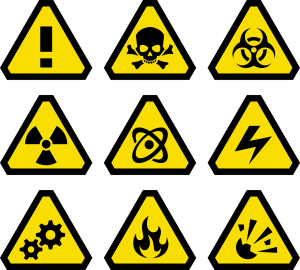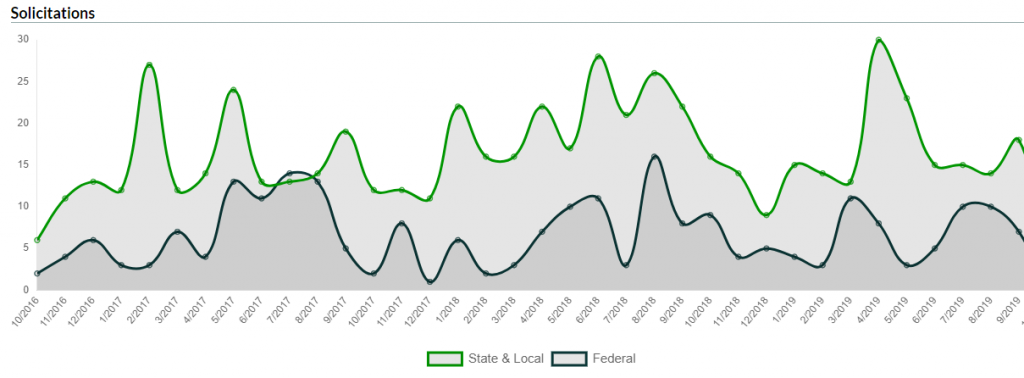State, local, and federal agencies are making major investments to bolster their ability to issue public alerts and vital health or safety information during life-endangering emergencies. Such emergencies include severe weather events, contagious disease outbreaks, and active shooter situations—all of which have been on the rise over the past year.
Additionally, agencies are ramping up their spending to improve safety at public schools.
These trends point to opportunities aplenty right now for vendors of mass notification systems, gunshot detection technologies, “summon help” solutions, public claxons, and wares of all kinds useful for school security purposes.
Mass Notification Systems
Mass notification systems serve a dual purpose. One is to inform the public of emergencies and serious incidents. The other is to facilitate coordination of a governmental response to those emergencies and serious incidents.

What qualifies as an emergency or serious incident worthy of activating a mass notification system? The obvious answer is severe weather incidents, active shooter situations, and terrorist-related attacks. But those aren’t the only ones. Others can include wildfires, earthquakes, avalanche danger, child kidnappings (Amber alert), freight train tanker car derailments in populated areas, shoreline oil spills, discovery of groundwater contamination, salmonella poisonings, riots, and more—basically anything that poses a wide-scale threat to life, limb, or property, or that carries with it the potential to greatly disrupt people’s daily routines.
The expectation among government agencies is that the mass notification products, services, or solutions they acquire will allow them to respond to public health and safety threats faster, more efficiently, and with greater success. They expect their purchases to play a pivotal role in helping the community recover and return to normal. They expect that whatever they buy will aid in minimizing their post-event loss of revenue. Above all, they expect their investment will go a long way toward preventing failure cascades of the sort that produce career-damaging political fallout.
At BidPrime, we have detected a pattern in government acquisitioning of mass notification products, services, and solutions. Specifically, they are choosing vendors who can deliver:
- Intelligent notification systems
- Warning systems
- Outbound dialing/notification systems
- “Giant voice” claxon/alert systems
- Telephone alert systems
- Auto messaging systems
- Emergency mass notification systems
- Neighborhood-level notification systems
- Critical alert paging
- Facility warning systems
- Wireless panic alert systems
- Beacon warning systems
Notably, agencies are also investing in mass notification mechanisms for non-emergency applications. For instance, agencies commonly use these systems to internally communicate important information about special meetings, schedule changes, rollouts of new rules or regulations, event reminders, and the like. They also use them to pass along to the public information about services and billings updates or to request community input and conduct surveys.
A recent look ahead at this sector by MarketsandMarkets suggests that the revenue intelligence company’s previous forecast (referenced in our earlier report, “Mass Notification and Alert Systems Experiencing Dramatic Growth in Public Sector”) will prove accurate: in 2015, MarketsandMarkets estimated demand for mass notifications would propel the industry worldwide from a then $3.81 billion business to one pulling in $8.57 billion by 2020. That averages out to a compound annual growth rate (CAGR) of 17.6 percent. MarketsandMarkets predicts an even more robust CAGR for the five-year period beginning in 2019—18.8 percent on global growth from the current $7.3 billion to $17.3 billion by 2024.
Indeed, these are busy times for vendors of mass notification systems.
Mass Notification bid activty: State, local, federal (Source: BidPrime Market Analysis)

Sample Active Bids/RFPs
Mass Notification
Gunshot Detection and Active Shooter Countermeasures
Requests for gunshot detection systems and active shooter countermeasures have gone ballistic over the past 12 months. If you’ve followed the headlines, you already know the reasons for this. On the off chance you’ve not read, heard, or watched the news in a long while, agencies are hunting for these items because of the rise in the number of mass shootings taking place at schools, malls, and other public places.

Gunshot detection systems use audio and optical sensors strategically deployed throughout a town or city. When someone pulls a trigger in the vicinity of a sensor, the popping sound and muzzle flash are picked up and relayed to police headquarters. Dispatchers looking at a computer screen see a street map of the city; the location of the gunshots is boldly highlighted on that map. This allows them to faster send units to the scene. The technology also recognizes the sound and flash signatures of the weapons fired, so responding officers know before arrival the number and types of guns they can expect to encounter. These insights enable police to maximize the effectiveness of their response and in so doing more quickly subdue the gunman to prevent worse carnage.
Mordor Intelligence’s Market Overview on the Gunshot Detection Industry recently quantified the growing demand for these systems:
“The gunshot detection systems market is anticipated to register a CAGR of 26.29% during the forecast period, 2019-2024, to reach a market value of USD $7.83 billion by 2024.”
The tragedy of a mass-slaying is magnified if people blunder into an active shooter zone. This can happen when there is a lull in the shooting (as would be the case if the shooter paused to reload or to search for additional targets). As a result, governments have become increasingly keen to acquire and implement active shooter countermeasure solutions to help potential victims avoid danger or successfully shelter-in-place.
More is being spent as well to install gunshot detectors and active shooter countermeasures along the southern border, where these systems can help spot and foil drug-cartel violence. Agencies charged with protecting the border are said to be very interested in detectors capable of picking up the sound of footsteps where none should be heard (indicating that people are attempting to illegally enter the U.S. from Mexico by crossing over in open, unpopulated areas).
Currently, 14 companies dominate the gunshot detector and active shooter countermeasure business, but there is clearly room for additional players—especially those offering game-changing wares. The market leaders at this point are:
- Raytheon
- SST
- Shooter Detection Systems
- Acoem Group
- Battelle Memorial Institute
- Louroe Electronics
- Tracer Technology Systems
- Safety Dynamics
- Databuoy
- Rafael Advanced Defense Systems
- ELTA Systems
- Compagnie Industrielle Des Lasers (CILAS)
- Microflown Avisa
- Information System Technologies
Listen here as City of Atlanta CIO, Gary Brantley, was a guest on ‘The Big Bid Theory’ and makes mention of various local initiatives, among which is implementation of gunshot detection systems.
Panic/Distress Buttons
Authorities have figured out that dialing 911 to report an emergency isn’t always what’s called for. Sometimes, people need a way to immediately warn others to flee the vicinity of a person spotted brandishing a firearm or, perhaps, a suspicious package left unattended at the train station.
So, in order to enable quick thinking citizens to alert a large number of nearby others to an imminent threat, a growing number of jurisdictions are installing panic/distress buttons in places where people congregate, such as, an abundance of pedestrian traffic. If a person sees something, they’re provided a fast and easy way to alert others—pressing it initiates a loud alarm, bell or a calm but insistent voice telling people to summon police, exit the area, or take cover.
We noticed a rise in demand for panic/distress buttons a decade ago when colleges and universities began buying them so that students could feel safe walking at night from classrooms to their dorms or cars. However, in recent years, the demand has increased appreciably. Consider this excerpt from a very recent report in the Orlando Sentinel, headlined “Florida public schools may require ‘panic buttons’ if new bill is passed:”
“[T]he bill would require elementary, middle and high schools to install panic buttons in all of their buildings. As of now, the button would be used for evacuations, lockdowns and active shooters.”
School Security
In early October 2019, the number of reported school shootings in the U.S. stood at 22. For all of 2018 there were 24 such shootings. If the trend continues, this year’s total could be even higher. Regardless of the statistics these shootings have convinced officials to act swiftly so security at our nation’s schools is vastly improved.

This thinking is resulting in a substantial rise in the volume of school security and safety related bids/RFPs. This increase is made possible in many instances by recent federal, state, and local legislation authorizing the spending of substantial sums for added school security and safety. For example, Florida’s Marjory Stoneman Douglas High School—scene of a horrific 2018 shooting in which one heavily armed student killed 17 classmates and injured many more—is slated to spend $1 billion of state-allocated funds to beef up campus security.
On the whole, the types of products, services, and solutions being requested by governments for purposes of making schools more secure and safe are quite diverse. Here is only some of what we’re seeing requested daily:
- Security cameras
- Security guards
- Handheld radios
- Safety gear
- Video doorbell systems
- Social media monitoring software
- Mobile apps
- Door locks
- Staff education and training programs
- Crisis response counselors
- Mental health programs
- Shatter resistant windows and doors
- Threat extinguisher canisters
- Secondary barricades
Clearly, there are opportunities in abundance for vendors to satisfy this rising demand. You may discover that the opportunities are actually better than you suppose, if you ask the right questions. At BidPrime, we help you understand what those right questions are, then we supply you with the answers based on our deep-dive research and analysis.
Sample Active Bids/RFPs
School Security
In this report, we have examined only a fraction of the activity taking place in the area of school security solicitation. For a closer look, contact BidPrime to request your own customized Market Analysis.
Want detailed information on public sector use of mass notification/alert systems or school security? Want invaluable insights concerning any other industry? Call us at 888.808.5356 or visit BidPrime.


